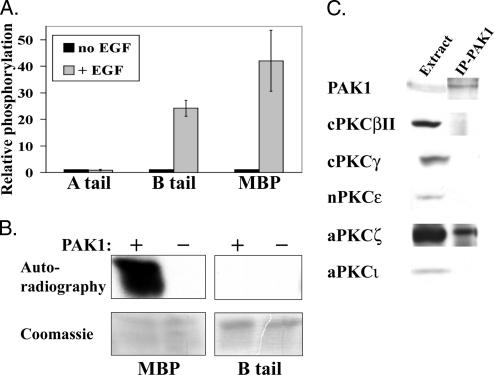Figure 1.
PAK1 is involved in NMHC II-B phosphorylation, but does not phosphorylate it directly. (A) IP-PAK1 phosphorylates NMHC II-B and MBP, but not NMHC II-A, in an EGF-dependent manner. Unstimulated TSU-pr1 cells or cells stimulated with EGF for 1 min were lysed, and PAK1 was immunoprecipitated and used in an in vitro activity assay with NMHC II-A tail, NMHC II-B tail, or MBP as substrates. The samples were separated on SDS-PAGE, and bands were excised and counted in scintillation counter. Results are shown as mean ± SD of three separate experiments. (B) Recombinant GST-PAK1 does not phosphorylate NMHC II-B directly. GST-PAK1 was used in an in vitro activity assay with MBP and NMHC II-B as substrates. The samples were separated on SDS-PAGE, stained with Coomassie, and exposed to autoradiography. The results are representative of three experiments. (C) aPKCζ coimmunoprecipitates with PAK1. The expression of the different PKC isoforms in TSU-pr1 cells was determined by resolving cell extracts on SDS-PAGE followed by Western blot analysis with antibodies specific for the different PKC isoforms. The association between PAK1 and PKC isoforms was determined by immunoprecipitating PAK1 from TSU-pr1 lysates and subjecting it to Western blot analysis with the appropriate antibodies. See Materials and Methods for details for this and all other figures.

